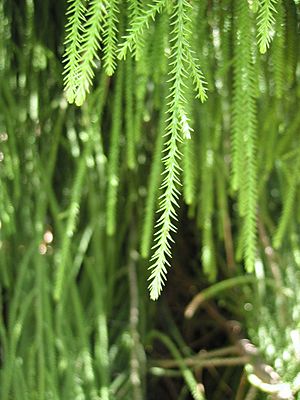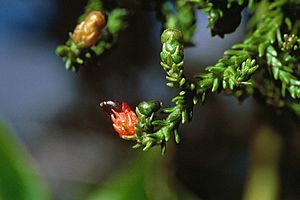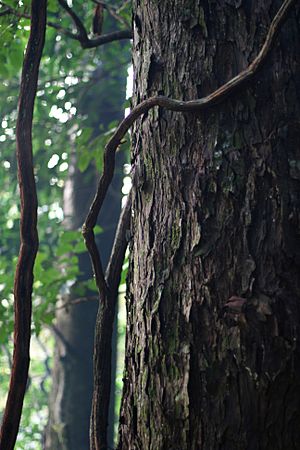Rimu facts for kids
Quick facts for kids Rimu |
|
|---|---|
 |
|
| A mature rimu | |
| Conservation status | |
| Scientific classification | |
| Genus: |
Dacrydium
|
| Species: |
cupressinum
|
 |
|
| Natural range of D. cupressinum | |
The Rimu tree, also known as Dacrydium cupressinum, is a very large evergreen tree. It is a type of coniferous tree, which means it has cones instead of flowers. Rimu trees are special because they only grow naturally in the forests of New Zealand. They are part of a group of southern conifers called podocarps.
Contents
Where Rimu Trees Grow
Rimu trees can be found all over New Zealand. They grow on the North Island, South Island, and Stewart Island/Rakiura. These trees are common in both lowland forests and mountain forests.
Most of the largest groups of rimu trees are now on the West Coast of the South Island. However, the very biggest individual trees often grow in mixed podocarp forests near Taupō. You can see an 800-year-old rimu tree at the Otari-Wilton's Bush in Wellington.
What Rimu Trees Look Like
Rimu trees grow slowly but can become very tall. They can reach up to 50 meters (about 164 feet) high. Most large rimu trees that are still standing today are between 20 and 35 meters tall. They often stand out above other trees in the forest.
These trees can live for a very long time, usually around 800 to 900 years! The main trunk of a rimu tree is usually about 1.5 meters (5 feet) wide. Very old or tall trees can have even wider trunks.
Rimu Leaves and Cones
The leaves of the rimu tree grow in a spiral pattern. On young plants, the leaves are up to 7 mm long. On older trees, they are smaller, about 2 to 3 mm long.
Rimu trees are dioecious. This means that male cones and female cones grow on separate trees. After pollination, the seeds take 15 months to become fully grown.
The mature cones are red and fleshy, about 6 to 10 mm long. They usually have one seed at the top. Birds help spread the seeds by eating the fleshy part of the cone and then dropping the seeds in their waste. These cones are an important food source for some birds, especially the kakapo. The kakapo's breeding cycle is even linked to when the rimu trees produce their fruit.
How People Use Rimu
The Māori originally used the strong, dark wood from the center of the rimu tree. They called this wood māpara or kāpara. They made items like combs and tools for preparing food from it.
In the past, rimu and other native trees like kauri, matai, and totara were the main sources of wood in New Zealand. This wood was used for making furniture and building houses.
However, many of New Zealand's original rimu forests have been cut down. Now, the government has rules that stop people from cutting down rimu trees in public forests. Some limited logging is still allowed on private land.
Today, another tree called Pinus radiata has replaced rimu for most industries. But rimu wood is still very popular for making high-quality wooden furniture. People also sometimes find old rimu stumps and roots from trees cut down long ago. They use this wood to make bowls and other carved objects.
The inner bark of the rimu tree can also be used to help treat burns and cuts.
Growing Rimu Trees
Even though rimu trees grow slowly and need a lot of moisture, many people grow them as ornamental trees in New Zealand. This means they are grown for their beauty in gardens and parks.
Rimu trees look attractive at all stages of their growth. When they are young, they are usually quite narrow. As they get older, they become wider with branches that hang down. Finally, they grow into their more upright adult shape. There is also a special type of rimu called 'Charisma' that has golden leaves and grows in a compact shape.
See also
 In Spanish: Rimu para niños
In Spanish: Rimu para niños





